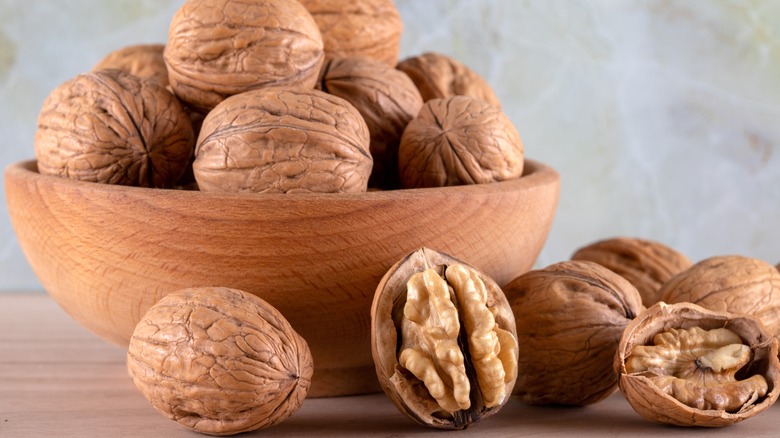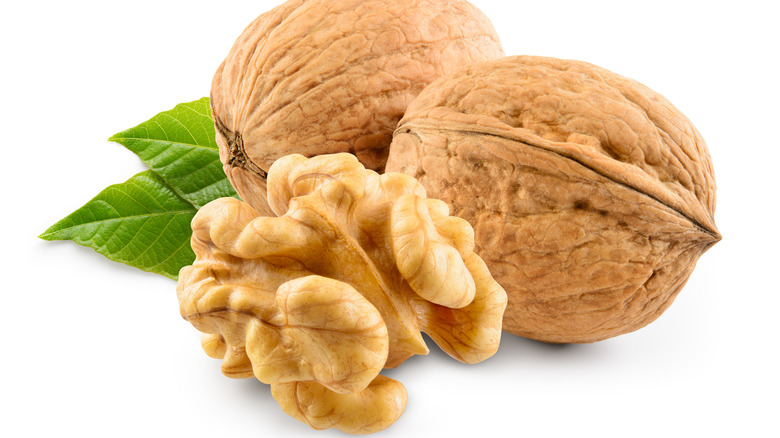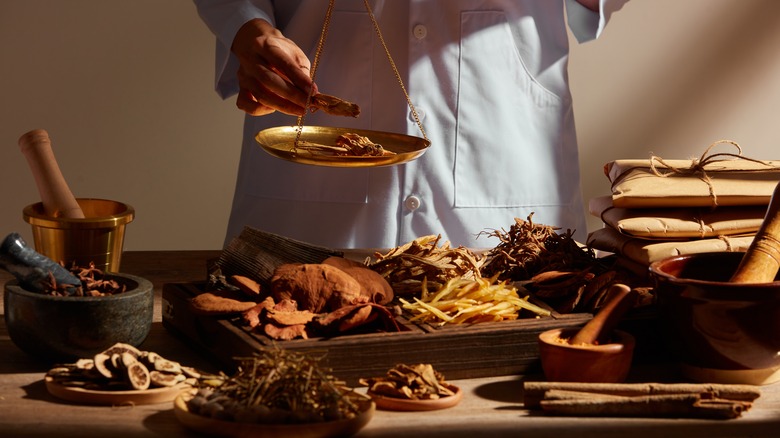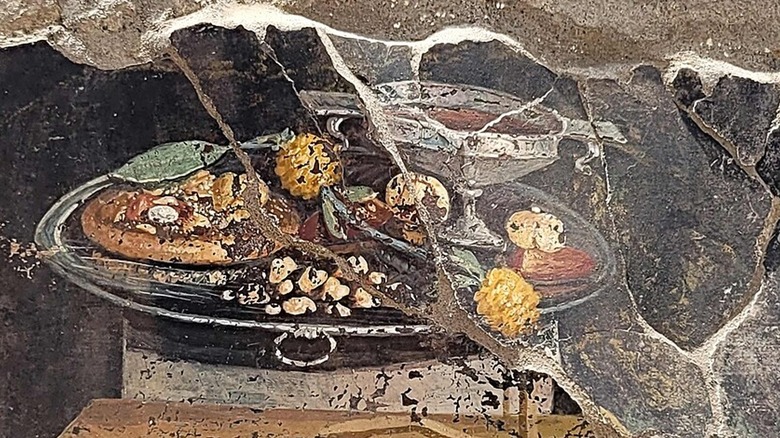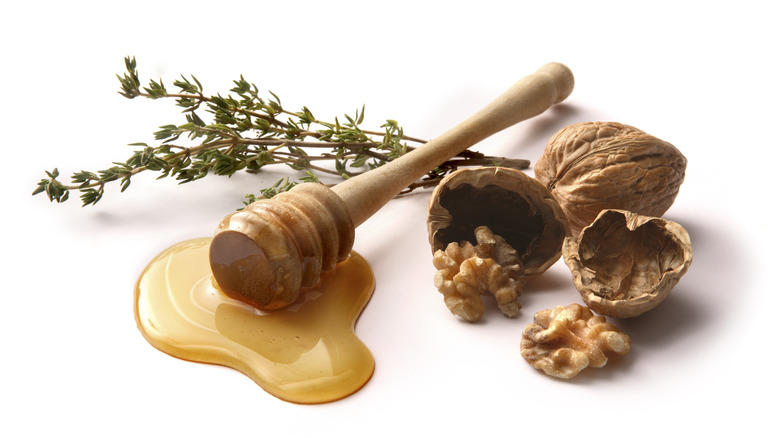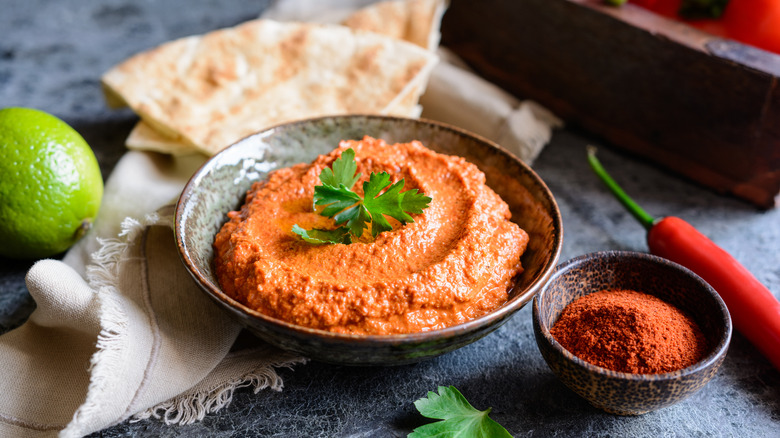The Strange Untold History Of Walnuts
From the courts of kings to the trade routes of old, the strange history of walnuts is not one you would expect. You've likely never considered just how ancient these nuts are and how they've been used from the moment humans first discovered these versatile nuts. They even have an interesting correlation to human language development, have had ceremonial uses, and were popular enough in one location to double as currency. They've had many strange uses you'd likely never guess, some of which have been more effective than others.
The more you learn about this amazing nut, the more likely you are to decide to eat them every day. While you may not trust it for some of the bizarre uses the ancients attributed to it, it has plenty of proven health benefits. As we uncover the walnut's history, you'll understand why it has endured from ancient civilizations to modern tables and likely beyond.
Walnuts date back several million years
Archeologists have encountered ancient fossils of walnut trees in Europe, Asia, and North America. The oldest walnut fossils scientists have encountered are from the species Juglans clarnensis, which grew in North America 44 million years ago. In Europe, the Juglans bergomensis variety shows up in the fossil records 11 million years later, making it a 33-million-year-old fossil. To put their existence into perspective, the earliest ones we know about existed 21 million years after dinosaurs went extinct and over 43 million years before homo sapiens walked the earth.
So when cavemen started looking for food, these nuts were available for foraging, although they weren't as widespread as they are now. While they existed long before humans, it wasn't until about 7,000 years ago, in the Bronze Age, that societies started cultivating them for dependable food sources. They seemed to first spread between the Balkans and Western Europe. Then, during the Roman Empire, they spread throughout Eastern Europe.
The world's largest producer of walnuts has a long history with them
China, the world's largest producer, has archeological evidence dating walnut trees in China to around 7,335 years ago. Supposedly, Zhang Qian returned with these trees after a western plant-finding expedition a Han dynasty emperor sponsored 2,100 years ago. Genetic analysis shows similarities between trees from Xinjiang and ones in other areas of China, suggesting the story could be true. Others insist that China didn't start growing them everywhere until Silk Road traders introduced them. So the ones from Xinjiang may have had sources as far away as Europe. Either way, China has had the nut for thousands of years, and their spread seems to have human origins.
While China produces the most walnuts in the world, they mainly keep them for their own population rather than exporting them. This fact makes sense since the Chinese population consumes more of the nut than any other country worldwide. They've even become status symbols, such that wealthy buyers pay up to tens of thousands of dollars to acquire aged walnuts with the biggest size and most perfect symmetry.
Walnuts were traded on the Silk Road
Merchants traveled back and forth along Silk Road routes for over 1,500 years, starting around 130 B.C.E. While the Silk Road led to China, where European and Asian merchants could buy precious silk fabric, plenty of other goods besides silk traded hands. Both the nuts and trees made their way to faraway lands via the Silk Road. Today 72% of the world's walnut production and 64% of the world's harvested walnut area are in Silk Road countries.
Not only do scientists think that merchants traded these nuts along the Silk Road, but they also hypothesize that some people even planted whole groves along the way. They likely planted the ones with the most desirable traits for future use. The science behind this idea is related to the fact that they've found genetically-similar trees in long stretches going east to west. However, you would expect genetic diversity to move outward in a circular shape if wind or animals planted them rather than people. Scientists have also found walnuts in Iran that share genetics with ones around 2,250 miles away in the Himalayas.
The spread of walnuts is connected to the evolution of language
Scientists have found curious parallels between the way language in some areas has evolved and the spread of walnuts. When you look at the genetics of the Persian walnut in Asian forests, they correspond with the evolution of languages from Turkey to China.
While scientists were studying old walnut forests in Asia that they suspected had been purposefully planted, they started noticing that the word for "walnut" was similar in many of the languages in pockets around these forests. So, they decided to cross-reference a map of language similarities at these 39 sites with a map of nut genetic similarities. As they had hypothesized, the spread of the trees corresponded with how ten of the most common languages developed in those areas.
Researcher Paola Pollegioni explains the interconnectivity this way: "What is a barrier for humans and language is also a barrier for walnut. People can't interact, and walnuts can't naturally exchange pollen or seeds" (via Aramco World). Thus, in places without barriers (like deserts and mountains), similar tree genetics corresponded to similar words for "walnut."
Their shape caused ancient cultures to associate them with the brain and the testicles
Some ancient cultures tried to determine what a plant looked like to decide how it might be medicinally useful. This strategy likely didn't work in most cases with walnuts, but it was worth a try.
Meanwhile, the ancient Romans saw testicles when they looked at the nuts and called them "juglans," which is short for the "glands of Jupiter." This Roman name provided us with the scientific walnut genus name, Juglans, so the Romans assumed that they must be aphrodisiacs.
The name that the ancient Greeks gave walnuts is "karyon," which means "head." The longer you look at one – especially one in half of a shell – the more the wrinkled crevices make it start to look like a brain peeking up out of a skull. Thus, the Greeks used it in several head-related remedies, such as helping hair grow. The ancient Roman writer of "Natural History," Pliny the Elder, suggested them for infant hair growth and headaches. In medieval Europe, doctors prescribed them for head wounds and headaches. They also suggested them for mental illness and epilepsy.
Many cultures have used walnuts for medicinal purposes
Various groups have used different parts of walnuts in their traditional medicine. They've used leaves to repel mosquitos and kill lice, as well as for itching, acne, frostbite, and rheumatism. People have used the nut itself to help with memory, as an aphrodisiac, for colds, and to relieve constipation. They've also used it for dandruff, rheumatism, muscle pain, diabetes, and failing eyesight. Combined with mustard oil, the roots have been used to combat hair loss. People have used them to help with toothaches or decay, and have used the leaves and bark from the root as an antiseptic.
Greeks and Romans combined the nuts with honey and rue for breast inflammation and abscesses; they also combined walnuts with honey, salt, and onions to treat bites (from dogs or humans). They burned the nuts for colicky babies or offered babies burnt nuts to encourage hair growth. Nut plasters were popular for skin conditions like gangrene and carbuncles, or for pink eye and thinning or balding hair. For bruises, they added garlic to the plaster. Europeans started to eat them with vinegar or with rue (sometimes with garlic and salt added) in an attempt to ward off the plague in the late 1500s.
Native Americans created a juice from black walnut hulls to remove maggots from festering wounds — and also to deworm dogs, as anti-parasite medicine for livestock, and as a rheumatism medicine. Other groups have used the hull paste with mustard oil for healing wounds.
Modern science has proven some health benefits of walnuts
While we're often slow to trust traditional medicinal uses of plants, a few traditional uses for walnuts were valid ones. An article in the Proceedings of the Indian National Science Academy journal reveals a list of studies that show several potential walnut health benefits.
Studies show that the leaves are antioxidants, antibacterial, antifungal, antiviral, and help and may protect the gastrointestinal system. They also likely help lower lipids, blood pressure, and cholesterol. The green hulls may protect the liver and kidneys and are antibacterial and antioxidant. The actual nut is an antibacterial and antioxidant. It's also likely helpful for the thyroid. The seed shell helps heal wounds. Walnut oil may help relieve pain and inflammation. Meanwhile, the bark has antibacterial, antimycobacterial, antioxidant, and antifungal properties. Plus, it helps with clotting. The stem is antifungal. Meanwhile, the flower may help with inflammation, depression, and getting the right oxygen level to body tissues.
Studies show the potential for them to help reduce the risk of dementia, heart disease, Type 2 Diabetes, and cancer. The bark is useful as a toothbrush, not only because it's fibrous but because it contains juglone, which kills viruses, parasites, funguses, and bacteria. Dentists even use it to fight plaque and help whiten teeth.
Walnuts were among the carbonized foods found in Pompeii
It was fall in 79 C.E. when a volcano erupted and forever preserved a day in the life of people in Pompeii, Italy. Archeologists have learned much about everyday ancient Roman life and food from what they uncovered from that day. Legumes archeologists uncovered lentils and beans. Tree products included olives, figs, crabapples, sour cherries, dates, and plums. Plus there were a few tree nuts, like almonds, chestnuts, and walnuts. Pliny the Elder, who wrote much about the virtues of the nut, was among those who died that day. So, it being among the remains isn't too surprising. Scientists were able to determine which specific varieties were present in Pompeii on that fateful day: common English or Persian walnuts (Juglans regia).
Frescos also helped provide evidence of what they ate. You see plenty of murals with seafood and meat. However, a fresco uncovered in 2023 seems to show a meal that includes walnuts, alongside what looks like a precursor to pizza, wine, and fruit that looks similar to tiny pineapples.
Walnuts feature in ancient and modern wedding rituals
Walnuts have been important enough to feature symbolically in weddings around the world since ancient times. In ancient Rome, they were a symbol of fertility, so brides could expect family and friends to throw walnuts at her as she made the trek from her family's home to the home where she'd soon live with her husband. Grooms in ancient Greece liked to sing dirty songs with their young friends at the wedding reception while throwing nuts all around. After all, dirty lyrics and symbols of fertility go hand in hand, right?
In some modern-day countries, weddings feature them as a symbol of fertility and honey as a symbol of sweetness. Couples in some Greek weddings eat a symbolic mixture of walnuts and honey with a silver spoon, while Armenian couples receive a similar mixture from the mother-in-law when they reach the home where they will live together.
Walnuts have been used as breath fresheners
Pliny the Elder talked about walnuts being a good choice for making breath smell better. He especially recommended following a meal containing onions with eating these nuts to help with your breath. This advice carried on through the years. Later, in the 1500s, Thomas Dawson wrote the exact same advice in his English cookbook.
In 2014, two young Nigerian students won a $1,000 prize at a science fair with their project which raised the question of whether walnuts can help with bad breath. They got the idea for the project after noticing they had fresh breath in the morning after eating walnuts before bed. No matter what they mixed the nuts with, the subjects in the experiment who ate the nuts had less hydrogen sulfide in their mouths and, thus, better breath. Modern-day dentists even sometimes suggest eating walnuts for halitosis since eating them helps remove bad-smelling bacteria on your teeth.
Walnuts were once thought to be a poison antidote
Pliny the Elder wrote about a poison preventative that was likely too good to be true. All you had to do was eat a mixture of two dried walnuts with twenty rue leaves, two figs, and salt. Oh, and you had to otherwise fast all day for it to work. So, if you were worried your enemies were trying to poison you, this concoction was supposedly all you would need to keep you safe.
Pliny got this recipe from a handwritten notebook belonging to King Mithridates, which General Pompey found among Mithridates' things after defeating him. The king supposedly drank poison every day in order to try to build immunity to it. Mithridates had plenty of other poison antidotes that he also used. However, this was the only recipe we know of containing these nuts. The king didn't ultimately die from poison, but not dying from poison doesn't necessarily prove his antidotes were effective.
Walnuts became extremely popular in Europe for a while
Emperor Charlemagne had his gardeners plant walnuts on his estates in the 800s. However, it's likely the Crusades in the 1000s that helped popularize them most. Soldiers introduced paste and sauce recipes from Muslim countries. During that century, they were in such demand in France that people could tithe walnuts instead of money to the church. At one point, you could even get a job as an official walnut measurer to prevent fraud.
When famine hit France in 1663, these nuts endured and sustained the hungry people, who could eat them alone or grind them into flour and add them to acorn flour to make bread. They came in handy again for small French villages low on food supplies during World War II.
A German doctor named Johannes Schröder started prescribing a sweet walnut concoction to help with digestion in the 1600s. Because of the idea that they were good for digestion, Europeans started adding them to desserts. However, during the same time, cookbook writers started to add them to dishes without giving any type of medical claims for them because they were plentiful and kept well.
Most U.S. walnuts come from California
Black walnuts are native to North America. However, it's Persian walnuts (also called English walnuts) that are the stars of U.S. walnut production. The best guess is that Franciscan priests brought them from South America to California in the 1770s. Because of their relationship to Spanish missions, people called them "mission walnuts."
It was nearly 100 years after they arrived in California that growers began producing them commercially in Santa Barbara County. Enough people planted them over time throughout the state that Persian walnuts from California eventually became the most popular type in the U.S. The majority grow in the Central Valley area. While Oregon and Washington grow them commercially, the world gets 99% of its U.S.-grown walnuts from California because the climate is perfect for them. The temperature, frost season, and precipitation amount are more ideal in California than in other areas of the country.
There's a strange walnut-related world record
If you like investigating strange world records, there's one related to walnuts. The top record-holder is the person who can use their forehead to smash as many walnuts with their forehead in a minute. The process involves placing nuts on multiple tables in whatever pattern they want. Then, competitors bend down and use their foreheads to smash as many as possible in 60 seconds. The only nuts that count toward the record are the ones that break into at least two pieces, so participants have to use a great deal of force to crack them.
The competitors smash quickly and furiously, hitting several nuts per second in a rhythm that sounds more machine than human. As you can imagine, the competitors come away with bruised and bloody foreheads.
As of 2023, Naveen Kumar of India holds the world record for smashing walnuts with his forehead at a rate of 273 a minute, which comes out to 4.55 nuts per second. Kumar and another competitor named Muhammad Rashid tend to trade the world record back and forth as they try to crush ever more nuts with their heads.
Walnuts have more uses than you think
Of course, you can eat the nuts raw or as an ingredient in various foods. However, you may not know you can boil the sap down into sweet, nutty syrup. Black walnut tea is popular in Asian countries and consists of a strained brew of rice water, dates, and nuts along with sugar. You can also use it to create a liquor called Nocino, which uses green nuts and requires six months to ferment to the right state.
If you've ever tried opening black walnuts with your bare hands, you've likely come away with stained hands. Observing this trait, Native Americans simmered the unripe hulls with water to make dark brown hair dye. It's also useful for dying cloth, or to turn into ink.
Making a powder from dried hulls is also useful for staining things when reconstituted with water. It's also possible to use shell powder to remove hazardous materials from water. The ground shells have also been used to clean airplane engine parts and to smooth gears from irregularities. Some companies use it as a filler product for dynamite or to help prevent tires from slipping. It's also helpful to strip paint or scrub chimneys. So the uses are many.
